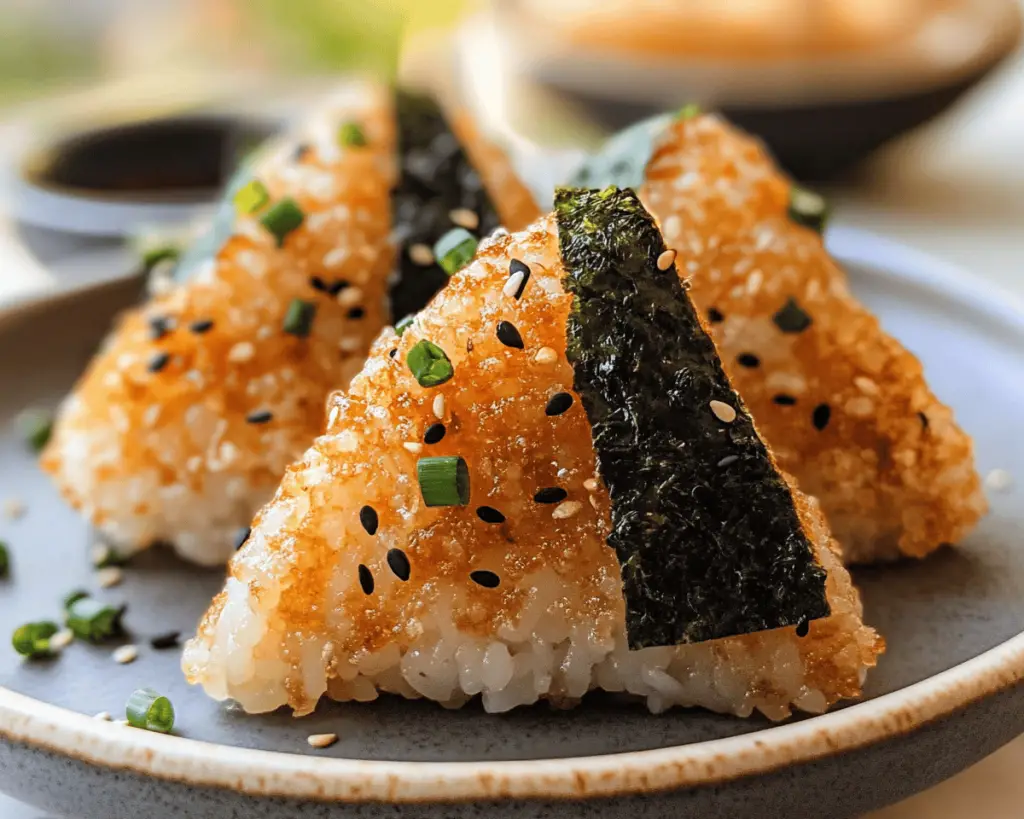I can still vividly remember the first time I tasted *yaki onigiri* — those beautifully grilled rice balls with a crisp outer layer, and the warm, comforting starchy interior. It was a chilly autumn afternoon, and I was sitting in a small, dimly lit Japanese izakaya, tucked away in one of those winding streets in a vibrant neighborhood of Tokyo. The air was thick with the smell of grilled meats and the soft murmur of conversation. As I took my first bite of the *yaki onigiri*, a rush of nostalgia coursed through me, even though it was the first time I had ever tasted it.
My friend Haruki had ordered them just for me. He knew that my culinary endeavors had taken me through various cuisines, but Japanese cuisine had remained a sacred haven, a place of comfort amidst the uncertainties of adulthood. Haruki explained how these triangular rice balls were made from leftover rice — a practical and delicious solution to avoiding waste. I was smitten. The salty, savory crust, enhanced by the charcoal-kissed edges, and the tender, flavor-rich rice they encased spoke to something deeper within me. In a way, they felt like little hugs, reminding me of the warmth of friendship and the beauty of resourcefulness.
Over the years, I’ve made this dish countless times — not just to replicate that first magical bite but to bring some of that spirit into my own home. Each time I fry up those little rice balls, I find myself revisiting memories, stirring old stories, and crafting new ones. I’ve shared them with friends at picnics, served them at intimate dinners, and even made them for myself after a long, exhausting day. With every bite, there’s a deeper connection to tradition, simplicity, and love enveloped in those little grains of rice.
Inside the Ingredients of Crispy Yaki Onigiri
Let us take a moment to walk through each element of this beautiful dish. It’s not just rice; it’s a symphony of flavors, memories, and traditions.
Cooked Rice:
The star of the show. Ideally, you want to use short-grain Japanese rice, like *koshihikari*, because its sticky quality allows the rice to hold its form when molded into shapes. The texture is essential; it should be tender yet still firm enough to give a satisfying bite. The sweetness of the rice carriers the meal’s soul — it speaks of harvest, of warm kitchens, and cloudless, sunny days. Rice was seldom wasted in my grandmother’s kitchen, and we’d often eat slightly cold leftovers shaped lovingly with warm hands.
Salt:
The seasoning that accentuates the rice’s natural flavor. Just a pinch goes a long way, transforming unassuming rice into something special. In the moments before I press the rice into triangles, I often hold the salt in my fingers, recalling the advice my mother always imparted: “A little salt can reveal a world of flavor hidden beneath.”
Soy Sauce:
This provides both umami and a slight sweetness to the surface of the *yaki onigiri*. With its complex flavor profile, soy sauce embraces the rice and adds an earthiness amid its simplicity. I devoted an entire afternoon to exploring different brands, understanding that soy sauce is such an intricate part of Japanese cooking, each bottle containing a tale from its region — some being sweeter, others darker and more assertive.
Nori (Seaweed):
Nori is where the crispiness meets softness. Once toasted lightly, the nori becomes an aromatic envelop for the rice. It adds depth and a contrast of textures that I absolutely adore. Each time I toast it, I’m brought back to my childhood beach trips with my family, snacking on *onigiri* wrapped with nori while we explored.
Vegetable Oil:
Used for frying, it creates that golden, crispy crust that brings joy with every bite. I’ve experimented with various oils over the years, sometimes indulging in the richness of sesame oil for a nuttier flavor, while other times sticking with a neutral oil for purity. The sizzle it makes when hitting a hot pan is akin to music—it signals the beginning of something beautiful.
How Crispy Yaki Onigiri Fits Into a Balanced Life
As a food lover, I’ve often grappled with the balance of nutrition and bliss. I care deeply for what I put into my body, yet I also find great joy in the comfort of cooking and meals steeped in emotion. *Crispy yaki onigiri* embodies this spirit perfectly. They’re not just delicious; they’re nostalgic and satisfying.
In terms of nutrition, these rice balls offer complex carbohydrates from the rice, giving energy without the spiking effects that processed foods can have. Pairing them with a side of pickled vegetables or miso soup transforms your meal into something slightly more balanced. It brings in enzymes and probiotics that do wonders for digestion — a wholesome approach to an indulgent bite.
When I set out to create this recipe, I embraced the idea of joy without guilt. There was a time in my life when I stood rigidly on the diet end of the spectrum, resisting foods that brought me pleasure. Then, I learned that food can nourish the soul and the body simultaneously — that joy in cooking can lead to mindful eating. This little rice song became a reminder that life’s pleasure is worth savoring.
In essence, the *yaki onigiri* embodies that balance of enjoyment and health. They’re the kind of food I can make for friends when they gather, a meal that celebrates togetherness, laughter, and love. Plus, adapting this recipe makes it all the more inclusive — add a filling of sautéed mushrooms or grilled vegetables to suit various diets. The possibilities are endless.
What You’ll Need
– Cooked Japanese short-grain rice: 2 cups
– Salt: 1 teaspoon, to taste
– Soy sauce: 1 tablespoon
– Nori seaweed: 2 sheets, cut into rectangles
– Vegetable oil: 2-3 tablespoons for frying
This recipe generously makes about 4 servings, but knowing how addictive they can be, you might find yourself craving more!
Preparing Crispy Yaki Onigiri Step by Step
Here’s where the magic happens. Gather your ingredients, take a deep breath, and let the comforting process begin. Rice is forgiving; it allows for mistakes, so don’t be intimidated.
Start by ensuring that your cooked rice is at room temperature. If you’ve gotten it straight from the pot, you can spread it onto a snug plate to cool down. Once it’s cooled, add your salt and soy sauce. Mix gently but thoroughly — you don’t want to crush the rice, just ensure that they’re flavored evenly. It’s that deep, salty-sweet aroma that brings me worlds of joy.
Next, here comes the cute part — the shaping! Wet your hands slightly to prevent the rice from sticking and grab a handful of rice. Shape it into a triangle or a round ball; I prefer the triangle for its nostalgic quality, but let your heart lead. Aim for compactness but don’t overdo it; we want them to hold together, but we’re not aiming for boredom.
Once your rice balls are formed, you can take a couple of minutes to toast your nori. Place it over an open flame, or use a dry skillet. Just a few moments on each side will do; you’re looking for that wonderful scent rather than a char. As the nori crisps, remember that it’s an ingredient that comes with its own stories and traditions.
Now for the frying — heat a skillet over medium heat and add your vegetable oil. Here’s a little tip: make sure the oil is hot enough before adding the *onigiri*. A simple test is to sprinkle a couple of drops of water into the pan; if they sizzle, you’re ready. Fry the rice balls for about 3-4 minutes on each side or until they achieve that golden, crispy exterior. Don’t panic if it looks a bit messy — mine always does. It’s part of the charm!
Once they’re done, let them drain on paper towels, and take a moment to enjoy the smell — it’s everything. Don’t forget your lovely pieces of toasted nori; wrap them around the onigiri like a little present. Serve them warm, perhaps with some pickled cucumbers or a dollop of wasabi for that extra kick.
Lessons from My Kitchen
Every dish holds lessons, and this one is no exception. With time comes experience, and each failure laid the groundwork for future successes. I recall one night in particular, where I tried to recreate these for a dinner party. My excitement led to using rice that wasn’t sticky enough. They crumbled in the skillet, leaving me scrambling to cook something else. The lesson? Stick to quality ingredients. They’re the backbone of your dish.
I’ve also learned to embrace seasonal twists with crispy yaki onigiri. Fresh summer corn folded in, or a sprinkle of herbs from my garden — everything transforms it into something unexpected. My friend Sophia introduced me to the idea of stuffing them with leftover curry, which was genius. The endless variations make it easy to play with flavors and style.
There’s wisdom in waiting patiently for them to fry, too. Good things take time, after all. It reminds me of the sweet moments in life, where anticipation builds to create something unexpected.
Each time I cook this dish, it becomes something different. There are days filled with laughter and good company, days spent with myself quietly reflecting on a good book, or even days where I fail to shape them nicely but marvel at their imperfections. In the kitchen, there’s no right or wrong; there’s just living.
(Closing Thought)
Crispy *yaki onigiri* is more than just a meal; it’s a vessel carrying nostalgia, friendships, and joy. It’s a reminder of my early adventures with culinary exploration and the love surrounding shared meals. Every time I take a bite, I am connected to something greater than myself—a centuries-old tradition passed through generations.
As you create your own onigiri, I invite you to infuse it with your stories, your memories, and the warmth of your kitchen. Let it be the beginning of a new chapter, one filled with flavor, love, and community. No matter how it turns out, embrace every imperfection, for every grain of rice carries a journey yet to be shared.



